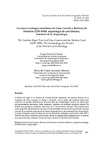Identificador persistente para citar o vincular este elemento:
https://accedacris.ulpgc.es/jspui/handle/10553/25203
| Campo DC | Valor | idioma |
|---|---|---|
| dc.contributor.author | Onrubia Pintado, Jorge | en_US |
| dc.contributor.author | González Marrero, María del Cristo | en_US |
| dc.date.accessioned | 2018-01-23T03:31:34Z | - |
| dc.date.accessioned | 2018-06-18T06:46:48Z | - |
| dc.date.available | 2018-01-23T03:31:34Z | - |
| dc.date.available | 2018-06-18T06:46:48Z | - |
| dc.date.issued | 2018 | en_US |
| dc.identifier.issn | 1133-598X | en_US |
| dc.identifier.uri | https://accedacris.ulpgc.es/handle/10553/25203 | - |
| dc.description.abstract | A finales del siglo xv la Corona de Castilla decide implicarse, de manera directa, en la conquista de Gran Canaria, La Palma y Tenerife. Con el inicio del conflicto bélico que conduce a la anexión definitiva de estas tres islas del archipiélago Canario, las únicas que aún permanecían insumisas, daba comienzo, también, un auténtico proyecto colonial de Estado que perseguía asimismo intervenir en el vecino litoral africano. Este trabajo tiene como propósito fundamental acercarse a la materialidad de esta doble experiencia colonial a través de un análisis conjunto de los datos arqueológicos y documentales hoy disponibles. Y lo hace tomando como estudios de caso las fortalezas realengas construidas entre 1478 y 1500 en dos de los territorios que balizan, desde la fragmentación impuesta por el océano, esta nueva frontera atlántica: la isla de Gran Canaria y la Berbería de Poniente. | en_US |
| dc.description.abstract | At the end of the 15th century the Crown of Castile decided to become directly involved in the conquest of Gran Canaria, La Palma and Tenerife. The beginning of this military conflict led to the definitive annexation of these three islands of the Canarian archipelago, the only ones yet to submit up till then. The same period also saw the first stages of a genuine state colonial project to intervene in the neighbouring African coast. This article approaches the materiality of this dual colonial experience through a joint analysis of current archaeological and documentary data. It does so by taking as case studies the royal fortresses built between 1478 and 1500 in two of the territories divided by the ocean that together demarcated this new Atlantic frontier: the island of Gran Canaria and the Barbary Coast. | en_US |
| dc.format | application/pdf | es |
| dc.language | spa | en_US |
| dc.relation.ispartof | Vegueta: Anuario de la Facultad de Geografía e Historia | en_US |
| dc.source | Vegueta: Anuario de la Facultad de Geografía e Historia [ISSN 1133-598X], n. 18, p. 167-208 | en_US |
| dc.subject | 55 Historia | en_US |
| dc.subject.other | Gran Canaria | en_US |
| dc.subject.other | Berbería de Poniente | en_US |
| dc.subject.other | Frontera atlántica | en_US |
| dc.subject.other | Conquista realenga | en_US |
| dc.subject.other | Fortificaciones | en_US |
| dc.subject.other | Arqueología | en_US |
| dc.subject.other | Western Barbary Atlantic Border | en_US |
| dc.subject.other | Royal Conquest | en_US |
| dc.subject.other | Fortifications | en_US |
| dc.subject.other | Archaeology | en_US |
| dc.title | Las torres realengas castellanas de Gran Canaria y Berbería de Poniente (1478-1500): arqueología de una frontera, fronteras de la Arqueología | en_US |
| dc.title.alternative | The Castilian Royal Towers of Gran Canaria and the Barbary Coast (1478–1500): The Archaeology of a Frontier at the Frontiers of Archaeology | en_US |
| dc.type | info:eu-repo/semantics/Article | en_US |
| dc.type | Article | en_US |
| dc.identifier.isi | 000423632200008 | - |
| dc.compliance.driver | 1 | es |
| dc.description.lastpage | 208 | en_US |
| dc.description.firstpage | 167 | en_US |
| dc.relation.volume | 18 | en_US |
| dc.investigacion | Artes y Humanidades | en_US |
| dc.rights.accessrights | info:eu-repo/semantics/openAccess | en_US |
| dc.type2 | Artículo | en_US |
| dc.contributor.daisngid | 6792127 | - |
| dc.contributor.daisngid | 2969956 | - |
| dc.utils.revision | Sí | en_US |
| dc.contributor.wosstandard | WOS:Pintado, JO | - |
| dc.contributor.wosstandard | WOS:Marrero, MDG | - |
| dc.date.coverdate | 2018 | en_US |
| dc.identifier.ulpgc | Sí | en_US |
| dc.description.esci | ESCI | |
| dc.description.fecytq | Q3 | |
| dc.description.fecytpuntuacion | 27,85 | |
| dc.description.dialnetimpact | 0,0 | |
| dc.description.dialnetq | Q1 | |
| dc.description.dialnetd | D3 | |
| dc.description.erihplus | ERIH PLUS | |
| item.grantfulltext | open | - |
| item.fulltext | Con texto completo | - |
| crisitem.author.dept | GIR IATEXT: Patrimonio cultural: textos, materialidades y memorias | - |
| crisitem.author.dept | IU de Análisis y Aplicaciones Textuales | - |
| crisitem.author.dept | Departamento de Ciencias Históricas | - |
| crisitem.author.orcid | 0000-0003-4280-8414 | - |
| crisitem.author.parentorg | IU de Análisis y Aplicaciones Textuales | - |
| crisitem.author.fullName | Onrubia Pintado, Jorge | - |
| crisitem.author.fullName | González Marrero, María Del Cristo | - |
| Colección: | Artículos Vegueta. n.18, 2018 | |
Citas de WEB OF SCIENCETM
Citations
3
actualizado el 25-feb-2024
Visitas
211
actualizado el 06-jul-2024
Descargas
1.291
actualizado el 06-jul-2024
Google ScholarTM
Verifica
Comparte
Exporta metadatos
Los elementos en ULPGC accedaCRIS están protegidos por derechos de autor con todos los derechos reservados, a menos que se indique lo contrario.
